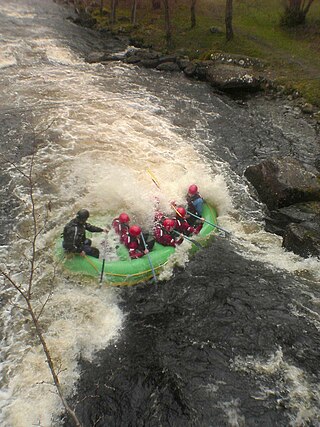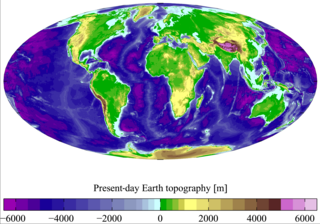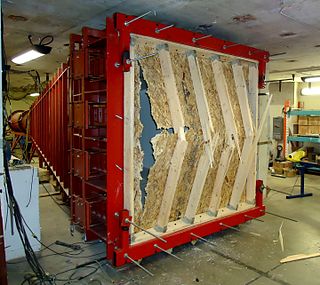Details
Ordinary shock waves are compressive, that is, they fulfill the Lax conditions: the characteristic speed (in air, the speed of sound) behind the shock is greater than that of the shock itself, which is greater than the characteristic speed in front of the shock. The characteristic speed is the speed of small, travelling perturbations. These conditions seem to be necessary for a shock wave to remain and not decay. If the peak of a wave moves faster than at its base, then the wave front becomes self-sharpening and eventually becomes a nearly discontinuous shock, a sharp wave front which remains so when it travels.
A shock wave is undercompressive if the Lax conditions are not fulfilled. A sharp wave front may remain sharp whilst travelling even when perturbations behind the front travel slower than it.
An experiment can be made to show this with travelling liquid steps : a thick film is spread on a thin one. The liquid steps remain sharp when they travel because the spreading is enhanced by the Marangoni effect. Making little perturbations with the tip of a hair, one can see whether shock waves are compressive or undercompressive.

In physics and engineering, fluid dynamics is a subdiscipline of fluid mechanics that describes the flow of fluids—liquids and gases. It has several subdisciplines, including aerodynamics and hydrodynamics. Fluid dynamics has a wide range of applications, including calculating forces and moments on aircraft, determining the mass flow rate of petroleum through pipelines, predicting weather patterns, understanding nebulae in interstellar space and modelling fission weapon detonation.

In physics, a shock wave, or shock, is a type of propagating disturbance that moves faster than the local speed of sound in the medium. Like an ordinary wave, a shock wave carries energy and can propagate through a medium but is characterized by an abrupt, nearly discontinuous, change in pressure, temperature, and density of the medium.

The speed of sound is the distance travelled per unit of time by a sound wave as it propagates through an elastic medium. At 20 °C (68 °F), the speed of sound in air is about 343 metres per second, or one kilometre in 2.91 s or one mile in 4.69 s. It depends strongly on temperature as well as the medium through which a sound wave is propagating. At 0 °C (32 °F), the speed of sound in air is about 331 m/s.
Compressible flow is the branch of fluid mechanics that deals with flows having significant changes in fluid density. While all flows are compressible, flows are usually treated as being incompressible when the Mach number is smaller than 0.3. The study of compressible flow is relevant to high-speed aircraft, jet engines, rocket motors, high-speed entry into a planetary atmosphere, gas pipelines, commercial applications such as abrasive blasting, and many other fields.
Soap films are thin layers of liquid surrounded by air. For example, if two soap bubbles come into contact, they merge and a thin film is created in between. Thus, foams are composed of a network of films connected by Plateau borders. Soap films can be used as model systems for minimal surfaces, which are widely used in mathematics.

A hydraulic jump is a phenomenon in the science of hydraulics which is frequently observed in open channel flow such as rivers and spillways. When liquid at high velocity discharges into a zone of lower velocity, a rather abrupt rise occurs in the liquid surface. The rapidly flowing liquid is abruptly slowed and increases in height, converting some of the flow's initial kinetic energy into an increase in potential energy, with some energy irreversibly lost through turbulence to heat. In an open channel flow, this manifests as the fast flow rapidly slowing and piling up on top of itself similar to how a shockwave forms.

Physical oceanography is the study of physical conditions and physical processes within the ocean, especially the motions and physical properties of ocean waters.

The shock tube is an instrument used to replicate and direct blast waves at a sensor or a model in order to simulate actual explosions and their effects, usually on a smaller scale. Shock tubes can also be used to study aerodynamic flow under a wide range of temperatures and pressures that are difficult to obtain in other types of testing facilities. Shock tubes are also used to investigate compressible flow phenomena and gas phase combustion reactions. More recently, shock tubes have been used in biomedical research to study how biological specimens are affected by blast waves.

The Marangoni effect is the mass transfer along an interface between two phases due to a gradient of the surface tension. In the case of temperature dependence, this phenomenon may be called thermo-capillary convection.

The phenomenon called tears of wine is manifested as a ring of clear liquid, near the top of a glass of wine, from which droplets continuously form and drop back into the wine. It is most readily observed in a wine which has a high alcohol content. It is also referred to as wine legs, fingers, curtains, church windows, or feet.
Choked flow is a compressible flow effect. The parameter that becomes "choked" or "limited" is the fluid velocity.

Kurt Otto Friedrichs was a noted German-American mathematician. He was the co-founder of the Courant Institute at New York University, and a recipient of the National Medal of Science.

In physics, a "coffee ring" is a pattern left by a puddle of particle-laden liquid after it evaporates. The phenomenon is named for the characteristic ring-like deposit along the perimeter of a spill of coffee. It is also commonly seen after spilling red wine. The mechanism behind the formation of these and similar rings is known as the coffee ring effect or in some instances, the coffee stain effect, or simply ring stain.
Gas kinetics is a science in the branch of fluid dynamics, concerned with the study of motion of gases and its effects on physical systems. Based on the principles of fluid mechanics and thermodynamics, gas dynamics arises from the studies of gas flows in transonic and supersonic flights. To distinguish itself from other sciences in fluid dynamics, the studies in gas dynamics are often defined with gases flowing around or within physical objects at speeds comparable to or exceeding the speed of sound and causing a significant change in temperature and pressure. Some examples of these studies include but are not limited to: choked flows in nozzles and valves, shock waves around jets, aerodynamic heating on atmospheric reentry vehicles and flows of gas fuel within a jet engine. At the molecular level, gas dynamics is a study of the kinetic theory of gases, often leading to the study of gas diffusion, statistical mechanics, chemical thermodynamics and non-equilibrium thermodynamics. Gas dynamics is synonymous with aerodynamics when the gas field is air and the subject of study is flight. It is highly relevant in the design of aircraft and spacecraft and their respective propulsion systems.
The Marangoni number (Ma) is, as usually defined, the dimensionless number that compares the rate of transport due to Marangoni flows, with the rate of transport of diffusion. The Marangoni effect is flow of a liquid due to gradients in the surface tension of the liquid. Diffusion is of whatever is creating the gradient in the surface tension. Thus as the Marangoni number compares flow and diffusion timescales it is a type of Péclet number.

A wind instrument is a musical instrument that contains some type of resonator in which a column of air is set into vibration by the player blowing into a mouthpiece set at or near the end of the resonator. The pitch of the vibration is determined by the length of the tube and by manual modifications of the effective length of the vibrating column of air. In the case of some wind instruments, sound is produced by blowing through a reed; others require buzzing into a metal mouthpiece, while yet others require the player to blow into a hole at an edge, which splits the air column and creates the sound.
A supersonic airfoil is a cross-section geometry designed to generate lift efficiently at supersonic speeds. The need for such a design arises when an aircraft is required to operate consistently in the supersonic flight regime.

In fluid thermodynamics, Rayleigh–Bénard convection is a type of natural convection, occurring in a planar horizontal layer of fluid heated from below, in which the fluid develops a regular pattern of convection cells known as Bénard cells. Bénard–Rayleigh convection is one of the most commonly studied convection phenomena because of its analytical and experimental accessibility. The convection patterns are the most carefully examined example of self-organizing nonlinear systems.
Andrea Louise Bertozzi is an American mathematician. Her research interests are in non-linear partial differential equations and applied mathematics.
In physics and engineering, the thin-film equation is a partial differential equation that approximately predicts the time evolution of the thickness h of a liquid film that lies on a surface. The equation is derived via lubrication theory which is based on the assumption that the length-scales in the surface directions are significantly larger than in the direction normal to the surface. In the non-dimensional form of the Navier-Stokes equation the requirement is that terms of order and are negligible, where is the aspect ratio and is the Reynold's number. This significantly simplifies the governing equations. However lubrication theory, as the name suggests, is typically derived for flow between two solid surfaces hence the liquid forms a lubricating layer. The thin-film equation holds when there is a single free surface. With two free surfaces the flow must be treated as a viscous sheet.













